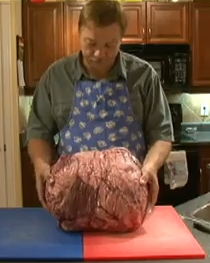In the kitchen, there are things that are the necessitites.
And then there are things that are not necessary but are really fucking awesome.
This post is about the latter.
I’ve used most if not all of these, and I can tell you right now, these are all worth saving for, putting on your christmas list, or just going out and getting because some of them aren’t that expensive.
1. Chef’n Silicone Spatula – $10
This thing is awesome. It has two ends, both of which are silicone spatulas. I use them for making eggs, I use them for frosting cakes. Pretty much anything I need a spatula for, I grab this.
2. Silipat Silicone Pan-Liner – $12
It’s like that silicone spatula above, except it’s for your baking pan. Nothing will ever stick to it. Ever. Evereverever. I bake cookies on it, I bake pizza on it and then I slide the pizza off when I’m finished. Don’t need to flour it or anything. I made peanut brittle once and it would have been a miserable endeavor without this. Anything you stick in your oven can go on this.
You can also use this for ghetto sous-vide. Just fold it and put it on the bottom of your pot and it’ll put an extra layer between your heat source and your food, help to keep the temperature even.
Just don’t ever cut anything on it. Use this instead:
3. NCAA Flexible Cutting Mat, pack of 2 – $8
These cutting boards are really useful. They take up less space than a solid cutting board and flexibility is always a plus, especially for getting what’s on your board to your pan (And not next to the pan, almost in the pan, on the floor, that crack between the oven and the counter where your food goes to fester for all eternity… etc.). They’re also very price fair and last for a good, long time.
4. Silicone Cupcake Cups – $10
I know you missed hearing about silicone. Don’t worry, I couldn’t let you down. As I’m sure you’ve gathered, Silicone is pretty much as beneficial for the kitchen as it is for the porn industry. I don’t know how we ever survived without it.
5. George Foreman Grill – $18
Because grilled cheeses were meant to be made on a goddamn grill, that’s why.
To be honest, this is another one of those things that you’re glad you have when the situation calls for it. It makes like easier, and sometimes it’s just nicer to have your burgers grilled, instead of fried, and it’s nice to not need to add a shitton of fat for one grilled fried cheese.
6. KitchenAid Mixer – $100-$300
This is what I had in mind when I said “save up for” or “put on your christmas list”. As far as mixers go, these are the holy grail. Professional kitchens use them for tiny batches, and seeing as how you aren’t a professional kitchen, this is really all you could ever need. It mixes, it whips, it folds. Cakes, meringues, whipped creams, mousse … mmmm.
7. NorPro EZ-grip Granny Fork – $7
Somewhere between a spoon and a fork (but not anywhere int he spork family), pretty much infititely useful for stirring, stabbing, getting things from the pan to the plate, great for pasta. Julia Child admitted to loving it.
8. DIY Juice to Alcohol Kit – $10
This one is more fun than freakishly useful. I don’t really think I have to explain why.
9. Ball Wide-Mouth 1-pint Canning Jars, set of 12 – $18
Fuck canning, I use these for cups. Yep. I’m just that cheap.
And actually, I did later try canning, and it was pretty much the coolest thing ever. The cost of canning is actually comparable to the cost of buying canned goods. It’s really worth looking into.
10. Silicone Bowl Scraper – $7
Please stop scraping your cutting board with your knife. It’s killing your edge.
In fact, stop scraping anything with anything except this. This is the best for cleaning out a bowl of frosting or sauce and really getting that last bit. There’s seriously nothing more satisfying.








